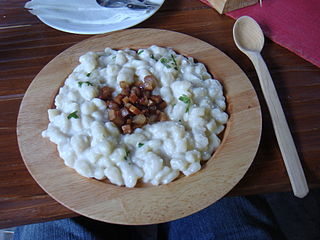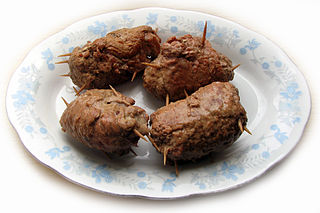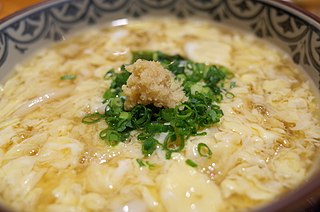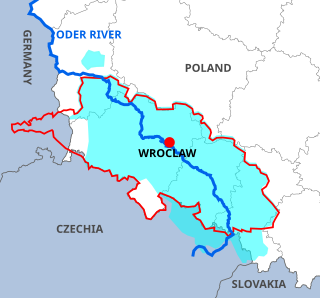Knödel, or Klöße are boiled dumplings commonly found in Central European and East European cuisine. Central European countries in which their variant of Knödel is popular include Austria, Germany, Hungary, Serbia, Croatia, Slovenia, Slovakia, and the Czech Republic. They are also found in Scandinavian, Romanian, Northern eastern Italian cuisine, Ukrainian and Belarusian cuisines. Usually made from flour, bread or potatoes, they are often served as a side dish, but can also be a dessert such as plum dumplings, or even meat balls in soup. Many varieties and variations exist.

Polish cuisine is a style of cooking and food preparation originating in or widely popular in Poland. Polish cuisine has evolved over the centuries to become very eclectic due to Poland's history and it shares many similarities with other West Slavic countries like neighbouring Czech and Slovak. It has also been widely influenced by other Central European cuisines, namely German, Austrian and Hungarian as well as Jewish, French, Turkish and Italian culinary traditions. Polish-styled cooking in other cultures is often referred to as à la polonaise.

Pierogi are filled dumplings of Central European origin, made by wrapping unleavened dough around a savory or sweet filling and cooking in boiling water, or pan-frying. Pierogi which consist of noodle dough and have to be cooked in boiling water are associated with the Central and Eastern European kitchens where they are considered national dishes. Their variant varenyky are popular in Ukrainian and Russian cuisine. Pierogi are popular in West Slavic, Hungarian, East Slavic, some Baltic and other Central and Eastern European cuisines, where they are known under their local names.

Czernina is a Polish soup made of duck blood and clear poultry broth. Sometimes known as "duck soup", hen, rabbit or pig blood can also be used. In English it can be called "duck blood soup".

Halušky are a traditional variety of thick, soft noodles or dumplings cooked in the Central and Eastern European cuisines. Halušky can refer to the dumplings themselves, or to the complete dish.

Kopytka, kapytki are a kind of potato dumpling in Polish, Belarusian, and Lithuanian cuisines. They are similar to Italian gnocchi and German Schupfnudel.
Kluski is a generic Polish name for all kinds of soft, mushy dumplings, usually without a filling. At times the word also refers to noodles and pasta as well, especially when they are served in soup. Kluski are distinct from pierogi and stand-alone pasta dishes. There are many different types of kluski, differing in basic ingredients and preparation method.
Kluski is a Polish name for various kinds of noodles and dumplings.

Plum dumplings, popularly known as knedle, is a dish of boiled potato-dough dumplings filled with plums, popular in Central and East European cuisines. The dish is eaten as dessert, a main dish, or side dish.

Silesian cuisine is an umbrella term for all dishes with a specific regional identity belonging to the region of Silesia. It is a subtype of Polish and German cuisine with many similarities to and signs of the influence of neighbouring cuisines.

Silesian dumplings are potato dumplings traditional to the Silesia region of Poland and Germany. Also called białe kluski.

Dumpling is a broad classification for a dish that consists of piece(s) of dough wrapped around a filling or of dough with no filling. The dough can be based on bread, flour, or potatoes, and may be filled with meat, fish, cheese, vegetables, fruits, or sweets. Dumplings may be prepared using a variety of methods, including baking, boiling, frying, simmering, or steaming, and are found in many world cuisines.

Egg drop soup or Danhuatang is a Chinese soup of wispy beaten eggs in boiled chicken broth. Condiments such as black pepper or white pepper, and finely chopped scallions and tofu are optional, but commonly added to the soup. The soup is finished by adding a thin stream of beaten eggs to the boiling broth in the final moments of cooking, creating thin, silken strands or flakes of cooked egg that float in the soup. Egg drop soup using different recipes is known to be a simple-to-prepare soup in different East Asian and Western countries.

Pampuchy are a type of steamed yeast dumpling (kluski) or doughnut (pączek) in Polish cuisine. A cooked pampuch (sing.) has an oval, flat on the bottom shape, with a bouncy, mushy and soft consistency. Pampuchy or bułki na parze are served hot: either sweet or savoury.

Pierogi leniwe, leniwe - dumplings made of quark, eggs and flour, boiled in lightly salted water. Most frequently served with whipped cream, sour cream, sugar or bespeckled with butter, fried bread crumbs, as well as with sugar and cinnamon.
Opole cuisine is an umbrella term for all dishes with a specific regional identity belonging to the region of Opole. It is a subtype of Polish and German cuisine with many similarities to and signs of the influence of neighbouring cuisines.

Pyzy are a type of dumpling (kluski). The dish is most commonly referred to in its plural for pyzy, as it is most commonly served as a main course meal: large oval-shaped kluski, characteristic to Polish cuisine.

In Polish cuisine, kluchy połom bite is a traditional and regional kluski made from specially whipped potatoes entwined with flour, characteristic for the Gmina Kroczyce. In other regions of Poland the dish is known by other names, including prażucha ziemniaczana and fusier.
















